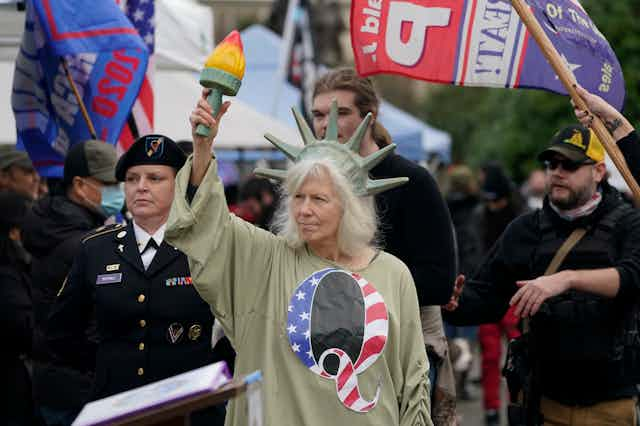Only 14 per cent of Capitol riots arrestees to date have been women, and yet women played key leadership roles that are important in understanding alt-right movements. Playing into gendered assumptions, researchers of the alt-right tend to characterize women’s participation as passive, with the demographics of Capitol riots arrestees revealing the predominance of white, middle-aged, middle-class men.
However, in our research on digital media and disinformation related to the Capitol riots, we have found that women served key leadership functions in the organization and performance of the riots. They planned events, provided a gentler face for the alt-right, nurtured social cohesion among participants and shaped the direction of the riots.
The intersection of race and gender
One commonality between men and women in the Capitol riots was that the vast majority were white. Yet, white women straddle two intersectional identities, one dominant (whiteness) and one oppressed (female).
This allows them to choose when and how to enact each identity. Far-right movements tend to rely on traditional gender roles, contributing in this instance to women’s adoption of the labels “classic woman” or “tradwife” — roles based on sex-realism.
Read more: Tradwives: the women looking for a simpler past but grounded in the neoliberal present
Sex-realism is the notion that women are biologically different from men and thus cannot be equal; while not considered subordinate, traditional roles for women are prescribed. Included in this alt-right form of feminism are race-based pressures to reproduce white children, associated with the racist rhetoric of “Make America Great Again.”
Women who participated in the Capitol riots performed traditional gender roles intersecting with racist rhetoric and actions. Our study of women’s participation at the Capitol riots identified four key groups: mobilizers, “QAMoms” (female QAnon conspiracy adherents), militias, and martyrs.
Mobilizers
Women played key roles in the organization of the Jan. 6 protest, with “Women for America First” (W4AF) serving as key mobilizers of the march-turned-riot.
In the weeks before the Capitol riots, W4AF held a 20-city bus tour with Bob Cavanaugh, a county commissioner in North Carolina saying, allegedly jokingly: “We’d solve every problem in this country if on the 4th of July every conservative went and shot one liberal.”
Republican representative Marjorie Taylor Greene also served as an instigator of the riot, posting on the far-right social network Parler and inciting protesters to interfere with the peaceful transition of power. She posted she needed “a grassroots army,” in a promoted parley that garnered 39 million views, 240,000 upvotes and 12,000 comments.
Mobilizers such as W4AF and Greene are typically well-known, well-funded women who operate behind-the-scenes, exercising a great deal of agency or social power.

Mothers of the movement
Women characterized as QAMoms, may be actual mothers and/or they may act as “mothers” of the movement. They have been introduced to conspiracy theories like QAnon, which exploit the nostalgia of an idealized past, through hashtags like #SaveTheChildren.
On the surface, this hashtag represents a movement against child sex trafficking, but it has been repurposed by QAnon and QAMoms to promote the far-fetched conspiracy that deep-state Democrats are a cabal of sex-trafficking satanists.
Women drawn to the alt-right through conspiracy theories and disinformation campaigns were seen at the Capitol riots leading prayers, providing first aid, organizing food and assuming stereotypical mothering roles. While playing into traditional gendered roles, these forms of mothering are also displays of leadership and social agency.
Militias
Alt-right women also, perhaps surprisingly, organize and participate in militias. Jessica Watkins, who served in the U.S. army in Afghanistan, was arrested and charged with seditious conspiracy for her alleged leadership role in the Capitol riots.
Watkins is transgender, and has been subjected to transphobic inhumane treatment in prison, up to and including being housed naked in a brightly lit cell for several days.
She is alleged to have actively recruited members from the Ohio State Regular Militia that she had founded, and to have planned a military style takeover of the Capitol. Watkins was seen during the riots dressed in military garb and moving with militia members in military stack formation.
Shaped by military training, women who participate in and lead militias performed skilled leadership activities in the riots, such as directing and leading others to attack police lines or scale walls, in their alleged attempt to overthrow the state.
Martyrs
At the Capitol riots, some participants dressed up and performed the roles of famous patriotic women. Others like Watkins were at the forefront of the incursion into the Capitol building.
One of the most dramatic deaths of the day was such a woman. Ashli Babbitt, a business owner and self-styled QAMom, was shot attempting to climb through a window to gain access to lawmakers in the House lobby.
Babbitt was immediately claimed as a martyr by far-right groups, barely moments after her death and against the wishes of her family. The outgoing POTUS Trump himself characterized her as having died at the hands of a corrupt government — despite the fact that he himself was President at the time of her death.
Working against their own interests
It may seem nonsensical for women to work against their own interests in supporting Trump, a man accused of sexual assault and misogyny. An explanation is contained within sex-realism, a particular worldview that many QAMoms hold. Instead of pointing to structures of patriarchy as oppressive, sex-realism is used by alt-right women to scapegoat immigrants and people of colour — those below them in society’s constructed racial hierarchies.
For tradwives, it may be easier to blame outsiders than to confront the fact that oppressive structures and behaviours may be enacted within their very families.

Yet, with the rise of global populism, we should not risk overlooking the contained agency of women participating in alt-right movements, where they mobilize disinformation, reinforce the traditional gender binary, promote conspiracies and enact racism.
The leadership of alt-right women ultimately paves the way for the escalating racist violence of male counterparts within the groups they lead, nurture and “mother.”

